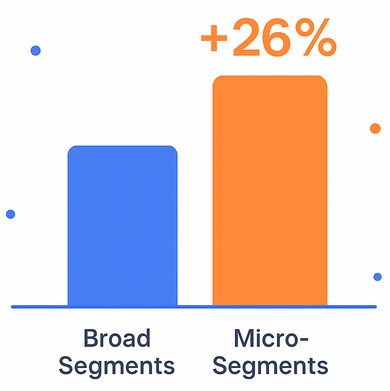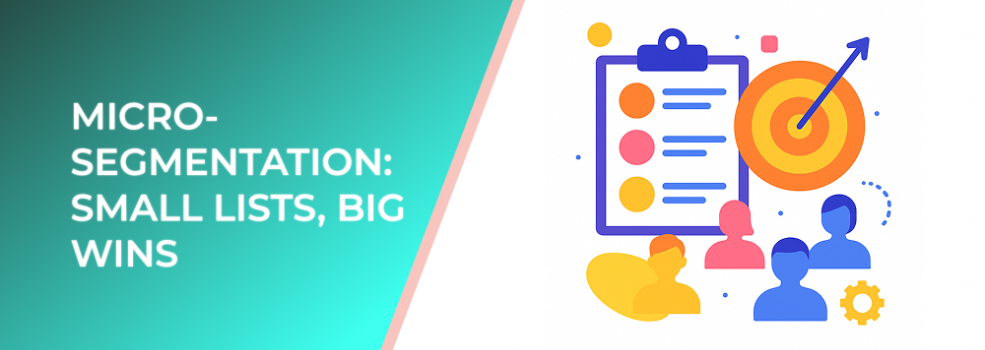Audience targeting has shifted from broad assumptions to precise, data-informed segmentation. Micro-segmentation pushes this evolution further by dividing audiences into tightly defined groups based on behavior, intent, and engagement patterns. Instead of targeting thousands, brands can target hundreds—or even dozens—of highly aligned prospects.
The result is clear: better ad relevance, higher conversion rates, and leaner acquisition costs.
Why Micro-Segmentation Works
Micro-segmentation takes advantage of real user insights rather than demographic generalities. According to recent industry benchmarks, marketers who use high-granularity segments see an average 26% lift in conversion rates compared to campaigns using broad segments.

Micro-segmentation drives a 26% higher conversion rate compared to broad segments
Another study found that personalized ads based on detailed behavioral clusters reduce customer acquisition costs by up to 30%. Smaller lists perform better because they are inherently more relevant.
Key Types of Micro-Segments to Use
1. Engagement-Based Segments
These segments categorize users based on recent actions—site visits, form submissions, product page views, or cart behavior. For example, segmenting “Visited pricing page in last 7 days” often identifies high-intent users.
2. Content-Interaction Segments
Group users by the type of content they consistently consume—blog readers, video viewers, whitepaper downloaders, or ad engagers. This allows you to deliver more relevant messaging and guide them toward the next step.
3. Recency & Frequency Segments

Users with three or more brand interactions are 2.4× more likely to convert
Recency and frequency metrics help identify highly engaged users. Data shows that users who interact with a brand more than three times within a week are 2.4x more likely to convert than those with only a single interaction.
4. Product- or Category-Level Interest
Divide audiences based on the exact product categories they browse or add to cart. Brands that do this often see up to 20% higher CTR due to improved relevance.
5. Lookback Window Variants
Testing multiple lookback windows—7-day, 14-day, 30-day—helps identify fast vs. slow decision-making users. Shorter windows often reveal higher purchase intent.
How Micro-Segmentation Improves Campaign Performance
Hyper-Relevant Messaging
Small segments allow you to tailor creative, offers, and landing pages to specific actions or interests. This level of relevance significantly increases engagement.
Stronger Conversion Signals
Platforms respond favorably to clean, high-intent signals. When your audience is composed of recent and meaningful engagers, algorithms optimize faster and more efficiently.
Lower Ad Costs
Irrelevant audiences drain budget. By excluding low-intent users, brands often experience 10–18% lower CPC and steadier acquisition costs.
Better Testing Opportunities
Micro-segmentation creates natural A/B testing buckets. You can quickly identify which actions, behaviors, or content types correlate with high conversion values.
How to Start Using Micro-Segmentation Today
Step 1: Audit Your Existing Data
Identify all available engagement points—website events, content interactions, product categories, or CRM triggers.
Step 2: Build Small, Action-Based Clusters
Start with segments of 200–2,000 users based on meaningful behaviors. This size is typically stable enough for ad delivery but focused enough for precision.
Step 3: Tailor Creative to Each Segment
Align messaging with the audience’s most recent action. For example, visitors to your pricing page should receive direct value messaging or incentives.
Step 4: Exclude Irrelevant Users
Use exclusion lists to prevent waste. Removing non-engaged visitors often improves conversion benchmarks across the entire funnel.
Step 5: Measure and Iterate
Track performance at the segment level—CPC, CTR, conversion rate—and refine based on emerging patterns.
Final Thoughts
Micro-segmentation is not about reaching everyone—it’s about reaching the right ones. As acquisition costs continue to rise, precision is becoming a competitive advantage. Brands that rely on small but meaningful audience clusters consistently outperform those relying solely on broad targeting.

